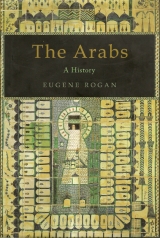
Текст книги "The Arabs: A History"
Автор книги: Eugene Rogan
Жанры:
Военная история
,сообщить о нарушении
Текущая страница: 9 (всего у книги 47 страниц)
Mishaqa was now the prisoner of the crowd. He was separated from his family and taken through the back streets to an official’s house. Mishaqa was, after all, the consul of a foreign state. One of Mishaqa’s Muslim neighbors gave his battered Christian friend sanctuary and reunited him with his family, all of whom—including his young daughter struck down by the crowd—miraculously survived the massacre. Only those Christians who found such safe refuge escaped the carnage. Some were rescued by Muslim notables, headed by the exiled hero of the Algerian resistance to French colonialism, the amir Abd al-Qadir. He and others risked their own lives to rescue and give shelter to fleeing Christians. Other Christians took refuge in the limited space of the British and Prussian consulates, whose guards succeeded in holding back the mob. The majority of those who survived took precarious shelter in the citadel of Damascus, fearful that the soldiers might let the mob through at any moment. While the majority of the city’s Christians did find safe refuge, thousands did not and suffered terrible violence at the hands of the mob in three days of carnage. Mishaqa later detailed the human and material costs of the massacres in a report to the American consul in Beirut. He claimed that no less than 5,000 Christians had been killed in the violence, one-quarter of a community that originally numbered 20,000. Some 400 women were abducted and raped, and many were left pregnant, including one of Mishaqa’s own house servants. The material damages were very extensive. More than 1,500 houses lay in ruins, all Christian-owned shops had been looted, and some 200 shops in the Christian quarters were put to the torch. Churches, schools, and monasteries were plundered and destroyed.14 The Christian quarters had been gutted by theft, vandalism, and fire in an irruption of communal violence unprecedented in the city’s modern history.
The Ottoman government had established legal equality between its Muslim and non-Muslim citizens largely to prevent the European powers from intervening in its domestic affairs. The ensuing violence against Christians in Mount Lebanon and Damascus engendered the prospect of a massive European intervention. Upon learning of the massacre, the French government of Napoleon III immediately dispatched a military expedition headed by General Charles de Beaufort d’Hautpoul, a French aristocrat who had advised the Egyptian army during its occupation of Syria in the 1830s. De Beaufort was charged with the mission of preventing further bloodshed and bringing to justice the perpetrators of violence against the region’s Christians. The Ottomans had to act quickly. They dispatched one of their highest-ranking government officials, an architect of the Ottoman reforms named Fuad Pasha, to take all necessary measures to restore order before the French expedition reached the Syrian coast. Fuad fulfilled his mission with remarkable efficiency. He set in motion a military tribunal to mete out severe punishments to all responsible for the breakdown in order. The governor of Damascus was sentenced to death for his failure to prevent the massacre. Dozens of Muslims, from the nobility down to the poorest urban workers, were publicly hanged in the streets of Damascus. Scores of Ottoman soldiers faced the firing squad for having broken ranks and participated in the murder and looting. Hundreds of Damascenes were exiled or marched away in chains to serve long prison sentences with heavy labor. The government set up commissions to address Christian claims for compensation for damaged and stolen property. Muslim quarters were emptied to provide temporary housing for homeless Christians while state-funded masons rebuilt the devastated Christian quarters. Basically, the Ottoman officials anticipated every grievance the European powers might raise and acted upon it before the Europeans had a chance to intervene. By the time General de Beaufort reached the Lebanese coast, Fuad had the situation under control. He thanked the French profusely for their services and provided them with a campsite on the Lebanese coast, far from any population center, where the soldiers would be on hand in case they were needed. The need never arose, and within a year the French withdrew their forces. The Ottomans had weathered the crisis, their sovereignty intact.
The Ottomans learned some important lessons from the experience of 1860. Never again would they pursue a reform measure that openly contravened Islamic doctrine. Thus, in the decades that followed, when the abolitionist movement and the British government combined forces to pressure the Ottoman Empire to abolish slavery, the Porte demurred. Verses of the Qur?an encourage owners to treat slaves well, to allow them to marry, and to give them their manumission, but slavery is in no way forbidden. How could the sultan outlaw that which God?s book permits? In an effort to accommodate British pressure, the Porte agreed to work instead toward the abolition of the slave trade, on which the Qur’an is silent. In 1880 the Porte signed the Anglo-Ottoman Convention for the suppression of the black slave trade. It was a compromise intended to preserve peace within the empire rather than to curb the institution of slavery.15 The Ottomans also recognized the need to balance reforms with benefits to win public support for the Tanzimat. The population at large did not gain from an expanded bureaucracy designed to tax them better or conscript them more efficiently into Western-style military service. All of the legal changes designed to make the Ottoman Empire more compatible with European political thought and practice were alien to the average Ottoman. To encourage its subjects to accept such alien changes, the Ottoman government needed to invest more in the local economy and in promoting social welfare. Large-scale projects that gave the public pride and confidence in the sultan’s government—such as gas lighting, steam-powered ferry boats, and electric trams—could generate support for the reformist government. The Porte needed to make such tangible, visible contributions to Ottoman society and the economy if the reform process were not to produce more disturbances. The second half of the nineteenth century witnessed massive state investment in building projects and public works throughout the Ottoman Empire. Two Ottoman vassal states—Egypt and Tunisia—enjoyed sufficient autonomy to pursue their own development programs. Having adopted Enlightenment ideas, the Ottoman world began to acquire advanced European industrial technology in a wild spending spree. Industrial goods and products reached Arab markets in ever-increasing diversity as the Ottoman world was drawn into the global economy of the late nineteenth century. 
Egypt led the way in modernization initiatives in the nineteenth century. Muhammad’Ali had invested heavily in industry and technology, though his projects were always undertaken with the military in mind. It fell to his successors to invest in Egypt’s civilian infrastructure. Abbas Pasha (r. 1848–1854) made a modest start when he granted a concession to a British firm to build a railroad between Alexandria and Cairo. Concessions were the standard contract by which a government encouraged private companies to undertake major investments in its domains. The terms of a concession would set out the rights and benefits accruing to both the investors and the government for a fixed period of time. The more generous the terms of a concession, the easier it was to attract entrepreneurs to one?s country. However, governments had to be careful not to concede too much to foreigners if they hoped for the enterprise to generate some profit for their own treasury. With governments in South America, Africa, and Asia vying for new technology, industrialists drove hard bargains. Abbas Pasha was a conservative man who preferred not to make many commitments to foreign investors. The next ruler of Egypt, Said Pasha (r. 1854–1863), committed the country to far more ambitious plans. He laid a second railway line between Cairo and Alexandria and awarded a concession for a new line from Cairo to Suez, completing the overland link between the Mediterranean and the Red Sea route to the Indian Ocean. He fostered Euro-Egyptian partnerships to bring steam shipping to the Nile and the Red Sea. Yet nothing could compare with the 1856 concession Said gave his former French tutor, Ferdinand de Lesseps, to construct a waterway linking the Mediterranean to the Red Sea: the Suez Canal. It was to prove Egypt’s greatest development project, and the biggest drain on Egypt’s treasury, of the nineteenth century. The granting of concessions was not in itself an expense to the treasury. If all of the ventures established by Egyptian concession-holders had succeeded, investors and governments alike would have profited. Unfortunately, many of these ventures were very risky and failed. This would have been bad enough for the host government, which had hoped to build stronger domestic economies through investment in European technology. Its losses were compounded by the demands of European consuls for indemnities when their citizens’ investments failed. As a matter of national pride, each consul took note of the indemnities received by the consuls of other states and sought to outdo them. Thus, when the Nile Navigation Company went bankrupt, the Egyptian treasury had to compensate European shareholders to the sum of Ј340,000.16 The Austrians set a new benchmark for individual claims when their consul managed to squeeze 700,000 francs from the government of Egypt to compensate an Austrian investor on the spurious grounds that twenty-eight cases of silk cocoons had been spoiled by the late departure of the Suez-to-Cairo train. Said was reported to have interrupted a meeting with a European businessman to ask a servant to close the window. “If this gentleman catches cold,” he quipped, “it will cost me Ј10,000.”17 The Suez Canal project generated the greatest indemnity bill of all. The British had objected to French plans to create a canal linking the Mediterranean and the Red Sea. Given its empire in India, Britain would inevitably be more reliant on the canal than any other maritime power. The idea of placing such a strategic waterway under the control of a French company was completely unacceptable to the British. They had no right to prevent the government of Egypt from offering concessions to its sovereign soil, but they could object to the terms of the concession. Specifically, the British objected to Egypt?s promise to provide free labor to dig the canal as tantamount to slavery, and they demanded that Egypt rescind those articles conferring rights on the Suez Canal Company to develop both banks of the canal in a colonization scheme. The Egyptian government was too reliant on Britain?s goodwill to refuse its objections, and it therefore notified the Suez Canal Company that it wished to renegotiate key terms of the original 1856 concession. The company turned the dispute over to the French government to defend its rights as a concession holder against British pressure. Said’s successor Ismail Pasha (r. 1863–1879) inherited the dispute and had to suffer the arbitration of the French emperor Napoleon III—hardly a disinterested party. In his settlement of 1864, Napoleon III demanded that the Egyptian government pay 38 million francs to the Suez Canal Company to compensate it for the loss of free labor, and 30 million francs for the land along the banks of the canal that was to be returned to Egypt. Additionally, he found reason to charge the Egyptian government an additional 16 million francs, making for a total indemnity of some 84 million francs (Ј3,360,000, about $33.5 million in 1864)—an unprecedented sum.18 In spite of its heavy losses to development projects, the government of Egypt remained optimistic about its economic future. Egypt’s most important export crop was long-staple cotton, prized by European weavers. In 1861 the supply of American cotton was cut by the outbreak of the Civil War. Between 1861 and 1865, cotton prices quadrupled. Egypt’s annual income from cotton rose dramatically from around Ј1,000,000 in the early 1850s to reach a peak of Ј11,500,000 by the mid-1860s. With cotton money flowing into Egypt’s coffers, Ismail Pasha believed he could honor his commitments to the Suez Canal Company and still undertake ambitious new projects. Ismail aspired to turn Egypt into a great power and to gain greater personal recognition as its ruler. In 1867 he sought Ottoman permission to change his gubernatorial title of “pasha” to khedive, a more impressive Persian title meaning “viceroy.” As khedive, Ismail sought to remake his capital city—Cairo—and took Paris for his example. With an eye to the ceremonies marking the opening of the Suez Canal in 1869, Ismail put Cairo on a course of rapid, radical transformation. Modern quarters with European-style buildings lining broad, straight streets were built between Old Cairo and the Nile. A new bridge was built across the Nile, and Ismail built himself a new palace on the main island in the Nile (it would later be converted to a hotel when the Egyptian government went bankrupt). The streets were paved and lit with gas fittings. Landscape architects turned the old Nile flood ponds, such as the Ezbekiyya pool, into public gardens with caf?s and promenades. A national theater and an opera house were built.19 The Italian composer Verdi was commissioned to write an opera with an Egyptian theme to inaugurate the opera house, but he took a bit too long to complete Aida, and the hall was opened to the strains of Rigoletto instead. The flurry of construction climaxed with the visit of the French empress Eugиnie to celebrate the opening of the Suez Canal in November 1869. The outrageous spending was part of Ismail’s bid to secure Egypt’s place among the civilized states of the world. Though the ceremonies were by all accounts most impressive, the new Cairo was a vanity project built on borrowed funds that left Ismail’s government living on borrowed time. The irony of the situation was that Egypt had embarked on its development schemes to secure independence from Ottoman and European domination. Yet with each new concession, the government of Egypt made itself more vulnerable to European encroachment. Egypt was not alone. Another state in North Africa was also increasing its dependence on Europe through ambitious reforms and development projects. Tunisia, like Egypt, enjoyed sufficient autonomy from the Ottoman Empire to pursue its own development projects in the nineteenth century. Its government, known as the Regency, had been headed by the Husaynid Dynasty since the early eighteenth century. Gone were the days of Barbary Coast piracy. Since 1830 the Regency had banned all piracy and sought to develop the economy of the country through industry and trade. Between 1837 and 1855, Tunis was ruled by a reformer named Ahmad Bey. Heavily influenced by the example of Muhammad ’Ali in Egypt, Ahmad Bey created a Nizami army in Tunisia, along with a military academy and support industries to produce the weapons and uniforms needed to provision the new army. Among the military men trained for the new army was a young Mamluk named Khayr al-Din, who would prove one of the great reformers of the nineteenth century, eventually rising to be prime minister both in Tunis and in the Ottoman Empire itself. As a Mamluk, Khayr al-Din was the last of his kind, a man who rose from slavery to the pinnacle of political power. In his autobiography, addressed to his own children, Khayr al-Din gave a rare insight into how it felt to be a Mamluk: “Though I know with certainty that I am a Circassian, I have no precise memory of my country or of my parents. I must have been separated from my family after some war or emigration, and lost trace of them forever.” Despite repeated attempts, Khayr al-Din never succeeded in his quest to find his biological family. “My earliest memories of childhood,” he wrote, “were in Istanbul, whence I passed into the service of the Bey of Tunis in 1839.”20 After learning Arabic and receiving an Islamic education, Khayr al-Din was enrolled in the military and trained by French officers. A brilliant young officer, he rose to the top of the officer corps and reached the rank of general before entering into political life?all within fourteen years of arriving in Tunisia. Fluent in French, Arabic, and Turkish, Khayr al-Din traveled widely through Europe and the Ottoman Empire in the course of his career. His firsthand experience of European progress made him an ardent supporter of the Tanzimat reforms and of the need to draw on European experience and technology to enable Muslim states to realize their full potential. He set out his views in an influential political tract published in Arabic in 1867, and in an authorized French translation two years later. Khayr al-Din addressed his reform agenda to both a European audience skeptical of the Muslim world’s ability to adapt to the modern age and to a Muslim audience that rejected foreign innovations as somehow contrary to the religion and values of Islam. Here Khayr al-Din was building on an argument first pronounced by the Egyptian advocate of reform, al-Tahtawi (Khayr al-Din had read and admired his book on France), to which later Muslim reformers would return increasingly across the nineteenth century: that Muslim borrowings from modern European sciences were but the return they were due from Europe’s debt to medieval Islamic sciences.21 Although Khayr al-Din was an outspoken advocate for political and economic reform, he was a fiscal conservative. He wanted to see Tunisia develop its economic base to be able to support the expense of modern technology. He believed the government should invest in factories to process its own cash crops into goods for the domestic market. He regretted how Tunisian laborers sold their raw cotton, silk, and wool “to the European for a cheap price, and then in a short time buy it back, after it has been processed [into manufactured cloth], at a price several times higher.”22 Far better, he argued, for Tunisian factories to spin and weave Tunisian fibers to produce fabrics for domestic consumption. In this way, the prosperity of the country would expand, allowing the government to invest in more infrastructural projects. Such financial sound management required intelligent government. Khayr al-Din watched with growing dismay as he saw the rulers of Tunisia take their country down the road to insolvency through vanity projects and bad investments. Tunisia is a relatively small country, and its expenditures on reforms were modest when compared to the projects undertaken in Egypt. The greatest expenditures undertaken during the reign of Ahmad Bey were related to the Nizami army. Because Ahmad Bey aspired to maintain an infantry of 26,000 men, he imported from France all of the necessary technology and work force to create support industries—arsenals, foundries, textile factories for uniforms, tanneries for saddles and boots, and so on. However, like Ismail Pasha in Egypt, Ahmad Bey also had his vanity projects. His most wasteful extravagance was a palace complex in Muhammadia, 10 miles south-west of the capital city Tunis, which he described as Tunisia’s Versailles. As expenditures increasingly outstripped resources, Ahmad Bey was forced to cut back on his ambitions. He ultimately abandoned many of the new factories at a total loss. Ahmad Bey?s successors continued the reform process, combining high expenditures on public projects with dwindling resources. A telegraph line was laid in 1859 to improve communications, and an aqueduct was built to provide fresh water to Tunis. A concession was given to a British firm to build a 22-mile railway linking Tunis with the port of La Goulette and the seaside town of al-Marsa. Gas lighting was introduced to Tunis, and the city streets were paved.23 Like Ismail Pasha in Egypt, the rulers of Tunisia wanted to endow their capital city with all the trappings of European modernity.
The reform process proceeded at a different pace in Istanbul and the other Ottoman provinces. As the imperial center, with responsibility for provinces scattered across the Balkans, Anatolia, and the Arab world, Istanbul had to ensure the development of all its provincial capitals. The government undertook major urban projects in the Arab world, building new markets, government offices, and schools. In addition, it introduced gas lighting and trams and other trappings of modern life in many of the Empire’s leading cities. The Ottomans also gave concessions to European firms to build major infrastructural projects. They modernized ports in Istanbul and Izmir, Turkey, and in Beirut. They set up steamship companies in the Black Sea and the Marmara Sea. A British firm received the concession in 1856 to build the first railway in Turkey, a 130-kilometer (81-mile) line from the port of Izmir to the agricultural hinterland of Aydin. A French company received the concession for a second line from Smyrna to Kasaba (93 kilometers, or 58 miles), built between 1863 and 1865. As these lines were extended, government revenues from the railways increased significantly, encouraging further investment in Anatolian railways. A number of industrial ventures were established in the Tanzimat era, and mines were founded to extract coal and minerals. However, profits from successful ventures were matched by losses in those that failed, and the returns on Ottoman investments in European technology never offset the costs of new technology.
Reckless government spending alarmed reformers across the Ottoman Empire and North Africa. The acquisition of European technology achieved the opposite of the intended result; instead of making these states strong and independent, the development process led to the impoverishment and weakening of Middle Eastern governments, increasing their vulnerability to European intervention. Writing about Tunisia, Khayr al-Din claimed, “It is clear that the excessive expenses which burden the kingdom beyond its capability are the result of arbitrary rule, and that economy, which is the course of the kingdom’s well-being, is attained by regulating all expenses within the bounds of the tanzimat.”24 For the development projects to bear fruit, Khayr al-Din argued, governments needed to stay within their means. The benefits of Tanzimat reforms were being undermined by arbitrary rule and excessive spending. To reform-minded thinkers like Khayr al-Din, the solution to both reckless government spending and arbitrary rule lay in constitutional reforms and representative government. The echoes of al-Tahtawi’s analysis of the French constitution could be heard very clearly in the second half of the nineteenth century. Under constitutional rule, a country would prosper, the people’s knowledge would increase, their wealth would accumulate, and their hearts would be satisfied. At least that was the theory. The Tunisian Constitution of 1861 fell well short of reformers’ hopes. The text of the constitution drew on the Ottoman reform decrees of 1839 and 1856 and placed few limits on the executive power of the bey, who retained the right to appoint and dismiss his ministers. However, it did call for the establishment of a representative assembly, the Grand Council, composed of sixty members nominated by the ruler. Khayr al-Din, appointed president of the Grand Council, was soon disillusioned by the assembly’s limited powers to curb the bey’s excesses. He recognized that Ahmad Bey and his prime minister had only convened the council to rubberstamp their decisions, and so in 1863 he tendered his resignation. The issue that provoked his resignation was the government’s decision to contract its first foreign loan, which Khayr al-Din predicted would drag his adoptive country “to its ruin.”25 The Egyptian constitutional movement took root in the 1860s as well. Following the lines of al-Tahtawi’s analysis, many reformers believed constitutional government to be the basis of European strength and prosperity and the missing link in Egypt’s own reforms. Yet, as in Tunisia, no change was possible without the consent of the ruler. It was the viceroy of Egypt, Ismail Pasha, who called for the creation of the first Consultative Council of Deputies in 1866. The council was composed of seventy-five members indirectly elected to three-year terms. Like the bey in Tunisia, the ruler of Egypt sought to implicate the landed notables in his controversial financial policies through the convening of the council, whose role was limited to a consultative capacity (deputies had no role in making the laws of Egypt). Though a creation of the ruler, the council became a forum for Egyptian elites to voice criticism of the policies of the ruler and his government, and it marked the beginning of broader participation in the affairs of state.26 The most significant constitutional movement in the Eastern Mediterranean emerged from Ottoman Turkey. Some of Turkey’s leading intellectuals met in Paris and London in the late 1860s, where they mixed with European liberals and framed a set of demands for constitutional government, the sovereignty of the people, and an elected parliament to represent the people. Known as the Society of Young Ottomans, they criticized the government for the poverty of Ottoman society and the financial condition of the state. Its members lamented the Ottoman Empire’s increasing dependence on the European powers as well as foreign intervention into Ottoman affairs, and they laid blame for Turkey’s problems squarely on the irresponsible policies of the sultan and his government. The Young Ottomans published newspapers and lobbied foreign governments to gain support for their cause. Even so, they recognized that change could only come with the consent of the sultan. Namik Kemal, one of the great Turkish intellectuals of the nineteenth century, told his fellow Young Ottomans that ?the Ottoman nation was loyal to its Ottoman rulers; with us nothing was done unless the [sultan] really wanted it.?27 The society dissolved in 1871 but returned to lobby its cause in Istanbul, where it found support among reformist government officials. The Young Ottomans’ efforts were rewarded in 1876 with the promulgation of the Ottoman Constitution and the convening of the first Ottoman Parliament. If reformers in Tunisia, Egypt, and the Ottoman Empire had hoped to stave off economic collapse by instituting constitutional reforms, they were to be sadly disappointed. The early constitutional movements were too respectful of authority to impose constraints on their rulers. They seemed to hope that the bey in Tunis, the pasha in Cairo, or the sultan in Istanbul would accept constraints voluntarily and share power with representative assemblies as an act of enlightened benevolence. These were not realistic expectations. The bey, pasha, and sultan continued to rule as before, and there was no constraint to prevent them from spending their governments into insolvency. 
The single greatest threat to the independence of the Middle East was not the armies of Europe but its banks. Ottoman reformers were terrified by the risks involved in accepting loans from Europe. In 1852, when Sultan Abdulmecid sought funds from France, one of his advisors took him aside and counseled strongly against the loan: “Your father [Mahmud II] had two wars with the Russians and lived through many campaigns. He had many pressures on him, yet he did not borrow money from abroad. Your sultanate has passed in peace. What will the people say if money is borrowed?” The advisor continued: “If this state borrows five piasters it will sink. For if once a loan is taken, there will be no end to it. [The state] will sink overwhelmed in debt.” Abdulmecid was convinced and canceled the loan, though he would return to European creditors within two years.28 In 1863 Khayr al-Din chose to resign as Tunisia’s president of the Grand Council rather than be party to the country’s first foreign loan. He later wrote bitterly of the policies that led to Tunisia’s bankruptcy in 1869. “After having exhausted all the resources of the Regency, [the prime minister] cast himself down the ruinous path of loans and in less than seven years . . . Tunisia, which had never owed anything to anyone, saw itself burdened with a debt of 240 million piasters [Ј6 million, $39 million] borrowed by the Government from Europe.”29 By Khayr al-Din’s estimate, the annual revenues of the Tunisian state had remained constant, at about 20 million piasters, right through the reform era. The result was that for seven years, expenditures exceeded revenues by 170 percent per annum. The result was the surrender of Tunisia?s sovereignty to an international financial commission.
The Ottoman central government was next to declare bankruptcy, in 1875. In the course of twenty years, the Ottomans had contracted sixteen foreign loans totaling nearly Ј220 million ($1.21 billion). With each loan, the Ottoman economy fell deeper into European economic dominion. Between discounts to attract increasingly skeptical investors and the various commissions and fees charged to float loans on European markets, the Ottoman government only received Ј116 million ($638 million)—the greater part of which was spent to service the Ottoman debt (some Ј19 million, or $104.5 million, in repayment and over Ј66 million, or $363 million, in interest). This left only Ј41 million ($225.5 million) for the Ottomans to invest in their economic objectives out of a total debt of Ј220 million ($1.21 billion). As Abdulmecid’s advisor predicted, the Ottoman state sank, overwhelmed in debt. Over the next six years, amid the tumult of another disastrous war with Russia (1877–1878) and territorial losses confirmed in the 1878 Treaty of Berlin concluding the war, the Ottomans finally came to an agreement with their European creditors in 1881 with the formation of the Ottoman Public Debt Administration (PDA). Headed by a seven-man council representing the main bondholder states (Britain, France, Germany, Austria-Hungary, Italy, the Netherlands, and the Ottoman Empire), the presidency of the PDA rotated between France and Britain. Whole sectors of the Ottoman economy were placed under the control of the PDA, with revenues from the salt monopoly, fish tax, silk tithes, stamp and spirit duties, as well as part of the annual tributes of several Ottoman provinces, dedicated to debt repayment. The lucrative tobacco trade also fell under the PDA, though a separate administration soon was created to oversee the monopoly over the purchase and sale of tobacco. The PDA gained tremendous power over the finances of the Ottoman Empire as a whole, which the European powers used not just to control the actions of the sultan’s government but to open the Ottoman economy to European companies for railways, mining, and public works.30








